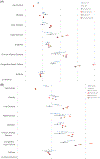Risk factors for severe outcomes of coronavirus disease 2019 through the waves of the pandemic: Comparing patients with and without solid organ transplantation
- PMID: 38980969
- PMCID: PMC11502248
- DOI: 10.1111/tid.14333
Risk factors for severe outcomes of coronavirus disease 2019 through the waves of the pandemic: Comparing patients with and without solid organ transplantation
Abstract
Background: While coronavirus disease 2019 (COVID-19) is no longer a public health emergency, certain patients remain at risk of severe outcomes. To better understand changing risk profiles, we studied the risk factors for patients with and without solid organ transplantation (SOT) through the various waves of the pandemic.
Methods: Using the National COVID Cohort Collaborative we studied a cohort of adult patients testing positive for COVID-19 between January 1, 2020, and May 2, 2022. We separated the data into waves of COVID-19 as defined by the Centers for Disease Control. In our primary outcome, we used multivariable survival analysis to look at various risk factors for hospitalization in those with and without SOT.
Results: A total of 3,570,032 patients were captured. We found an overall risk attenuation of adverse COVID-19-associated outcomes over time. In both non-SOT and SOT populations, diabetes, chronic kidney disease, and congestive heart failure were risk factors for hospitalization. For SOT specifically, longer time periods between transplant and COVID-19 were protective and age was a risk factor. Notably, asthma was not a risk factor for major adverse renal cardiovascular events, hospitalization, or mortality in either group.
Conclusions: Our study provides a longitudinal view of the risks associated with adverse COVID-related outcomes amongst SOT and non-SOT patients, and how these risk factors evolved over time. Our work will help inform providers and policymakers to better target high-risk patients.
Keywords: COVID; COVID‐19; N3C; SARS‐CoV‐2; solid organ transplantation; transplantation.
© 2024 Wiley Periodicals LLC.
Conflict of interest statement
CONFLICT OF INTEREST STATEMENT
Dr. Jin Ge receives research support from Merck and Co.; and consults for Astellas Pharmaceuticals/Iota Biosciences. Dr. Roslyn Mannon receives grant funding from VericiDx and is a consultant for Sanofi, Hibio, CSL Behring, Natera, and Chinook. Dr. Amanda Vinson is a consultant for Paladin Labs Inc. and Taketa Pharmaceuticals.
Figures



References
Publication types
MeSH terms
Grants and funding
LinkOut - more resources
Full Text Sources
Medical
Miscellaneous

